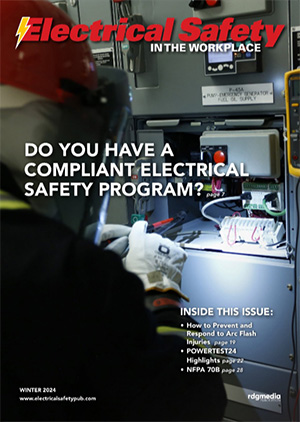Best Practices for an Electrical Safety Program
By Brianne Deerwester, Contributor
 While electrical hazards are not the leading cause of on-the-job injuries and accidents, they are disproportionately fatal and costly. Workplace electrical accidents not only disrupt the lives of workers and their families but also impact their employers and workplaces because of downtime and days away from work. Most on-the-job electrocutions and electrical injuries can be prevented by following the steps established in a workplace electrical safety program. Increasing awareness of electrical safety hazards and understanding the importance of following a comprehensive electrical safety program are the critical first steps for improving the electrical safety of a workplace.
While electrical hazards are not the leading cause of on-the-job injuries and accidents, they are disproportionately fatal and costly. Workplace electrical accidents not only disrupt the lives of workers and their families but also impact their employers and workplaces because of downtime and days away from work. Most on-the-job electrocutions and electrical injuries can be prevented by following the steps established in a workplace electrical safety program. Increasing awareness of electrical safety hazards and understanding the importance of following a comprehensive electrical safety program are the critical first steps for improving the electrical safety of a workplace.
The Electrical Safety Foundation International (ESFI) is the leading authority on workplace electrical safety. ESFI’s workplace safety materials provide valuable information to help employees make safe choices every day. The resources and tips outlined in those materials help to create a safer work environment, whether the work takes place in an office, on a job site, or in an industrial or manufacturing setting.
ESFI’s Know When to Say When – Know When to Stop Work infographic and Know When to Say When video strive to educate the workforce to exercise caution and prevent accidents before they can occur. The goal for all employers should be for all workers to go home safely at the end of a shift. To obtain this achievement, the electrical safety training program in place should teach workers to ask the following questions before engaging in a task:
- Have I been properly trained to safely complete this job task?
- Have I worked on this task before, and do I have the right training and experience?
- Do I have the proper tools for this job?
- Is the hierarchy of risk controls being followed to ensure that preventative and protective risk controls are being implemented?
- Has a proper risk assessment been performed?
- Are all conductors and circuit parts in an electrically safe working condition?
- Are these parts properly guarded to reduce the likelihood of electrical contact or arcing faults?
- Are all applicable procedures and job planning procedures completed?
- Am I confident about completing this job without risk or putting others at risk?
 Certain jobs require specific knowledge and expertise, so it is imperative to stop and reassess a task if there’s ever a question about completing it safely. If an issue arises on the job, additional briefings and planning should occur. It is better to be safe and ask a more qualified individual to complete a task than to suffer a workplace injury or fatality. Before beginning work, a proper risk assessment should be conducted to address what risks can occur, how likely the risks are to occur, and the consequences if the risk occurs. The goal of the assessment is to evaluate any potential workplace hazards and stop them from happening in the first place.
Certain jobs require specific knowledge and expertise, so it is imperative to stop and reassess a task if there’s ever a question about completing it safely. If an issue arises on the job, additional briefings and planning should occur. It is better to be safe and ask a more qualified individual to complete a task than to suffer a workplace injury or fatality. Before beginning work, a proper risk assessment should be conducted to address what risks can occur, how likely the risks are to occur, and the consequences if the risk occurs. The goal of the assessment is to evaluate any potential workplace hazards and stop them from happening in the first place.
The questions above and the hierarchy of risk controls seek to remove hazards and make work safer for all employees. The hierarchy begins with the most effective control at the bottom, elimination, which aims to eliminate hazards from the workplace. Next, substitution attempts to replace any potential hazards. Engineering controls separate workers from the hazard. Administrative controls change the way people work. The least effective method is protecting workers with their last line of defense, or PPE. By removing or replacing the hazards or workers from dangerous situations, a workplace accident can be prevented. All workers must know the limits of their qualifications.
Be Sure To Follow All Guidelines
Further workplace safety resources were created to provide innovative electrical training solutions for both managers and employees in electrical and non-electrical fields. Through compiling yearly workplace injury and fatality statistics, ESFI discovered that 40% of all electrical accidents on the job site are caused by overhead power lines. Most of these accidents are caused by non-electrical workers. These findings help to create new materials and prevent future incidents from occurring. The materials can be used to create an electrical safety program or to supplement an existing program with new resources created yearly. ESFI also recommends following the guidelines outlined in the “NFPA 70E: Standard for Electrical Safety in the Workplace.” The NFPA 70E is the National Fire Protection Association’s guidebook, which addresses electrical safety requirements for workplaces that are necessary for the practical safeguarding of employees to help prevent injuries and fatalities from electrocution, shock, arc flash, and arc blast. A revised and updated NFPA 70E edition is released every three years. The current version is the 2021 edition, which was recently released.
Educating the workforce of electrical hazards and how to avoid them requires a mutual effort between employees and employers. It is imperative all parties be involved in an electrical safety training program to prevent any accidents from occurring. If a job requires workers to be near electricity, an electrical safety program should be in place to teach workers how to avoid accidental contact with electricity. Download ESFI’s free-to-share electrical safety videos and infographics from esfi.org to amplify the electrical safety of your workplace. Distribute the content directly to your employees or your customers to help prevent future workplace injuries and fatalities and forward our mission of reducing electrically related deaths, injuries, and property losses at home and in the workplace.
Brianne Deerwester is the Communications Coordinator for the Electrical Safety Foundation International (www.efsi.org).
Share on Socials!
IP and NEMA Enclosure Ratings Explained
Create a Safe Work Environment with Arc Flash Labeling
Before You Get Started: Things to Consider in High Voltage Work
Leaders in Electrical Safety
• Aramark
• Bowtie Engineering
• Enespro
• Ericson
• I-Gard Corporation
• IRISS
• KERMEL, INC.
• Lakeland Industries
• MELTRIC Corporation
• National Safety Apparel
• National Technology Transfer
• Oberon
• Saf-T-Gard
• SEAM Group
Subscribe!
Sign up to receive our industry publications for FREE!







